engine RENAULT KANGOO 1997 KC / 1.G Foult Finding - Injection Workshop Manual
[x] Cancel search | Manufacturer: RENAULT, Model Year: 1997, Model line: KANGOO, Model: RENAULT KANGOO 1997 KC / 1.GPages: 363
Page 183 of 363
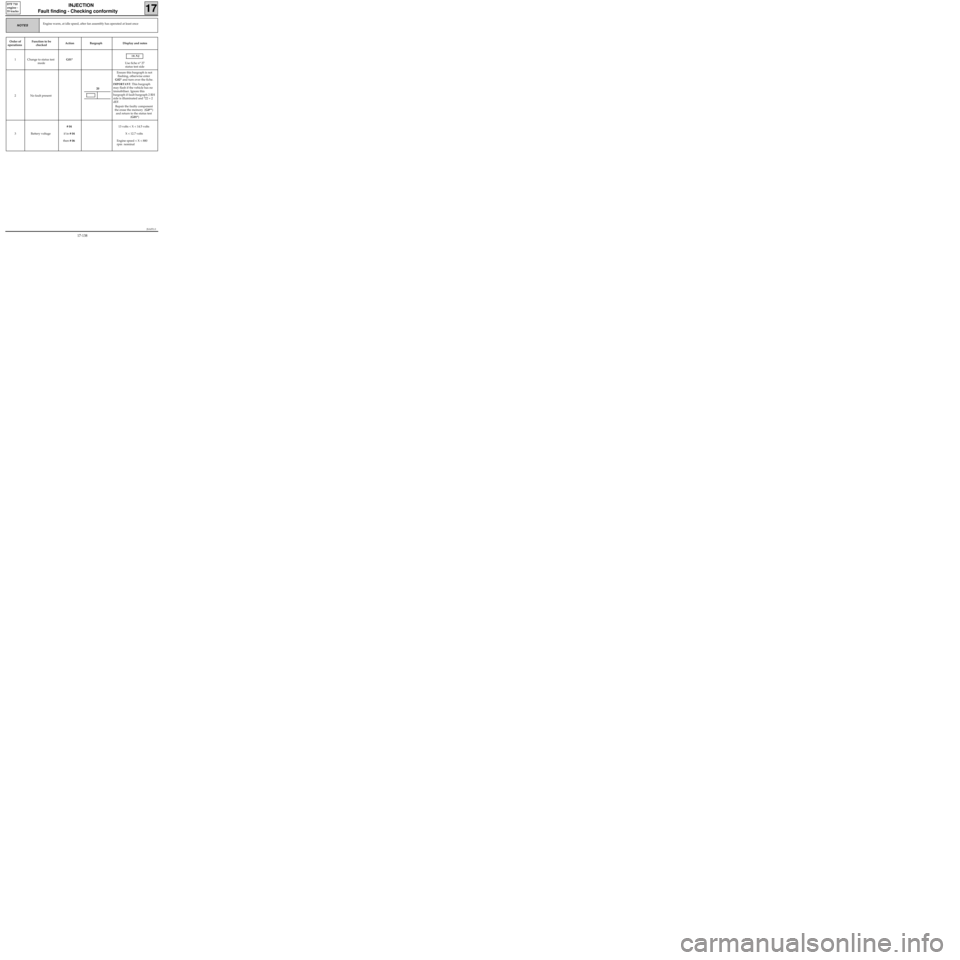
JSA051.0
INJECTION
Fault finding - Checking conformity
17
D7F 710
engine -
35 tracks
Order of
operationsFunction to be
checkedAction Bargraph Display and notes
1 Change to status test
modeG01*
10.NJ
Use fiche n° 27
status test side
2 No fault presentEnsure this bargraph is not
flashing, otherwise enter
G02* and turn over the fiche.
IMPORTANT: This bargraph
may flash if the vehicle has no
immobiliser. Ignore this
bargraph if fault bargraph 2 RH
side is illuminated and *22 = 2
dEF.
Repair the faulty component
the erase the memory (G0**)
and return to the status test
(G01*)
3 Battery voltage# 04
if in # 04
then # 06 13 volts < X < 14.5 volts
X < 12.7 volts
Engine speed < X < 880
rpm nominal
Engine warm, at idle speed, after fan assembly has operated at least onceNOTES
20
17-138
Page 184 of 363
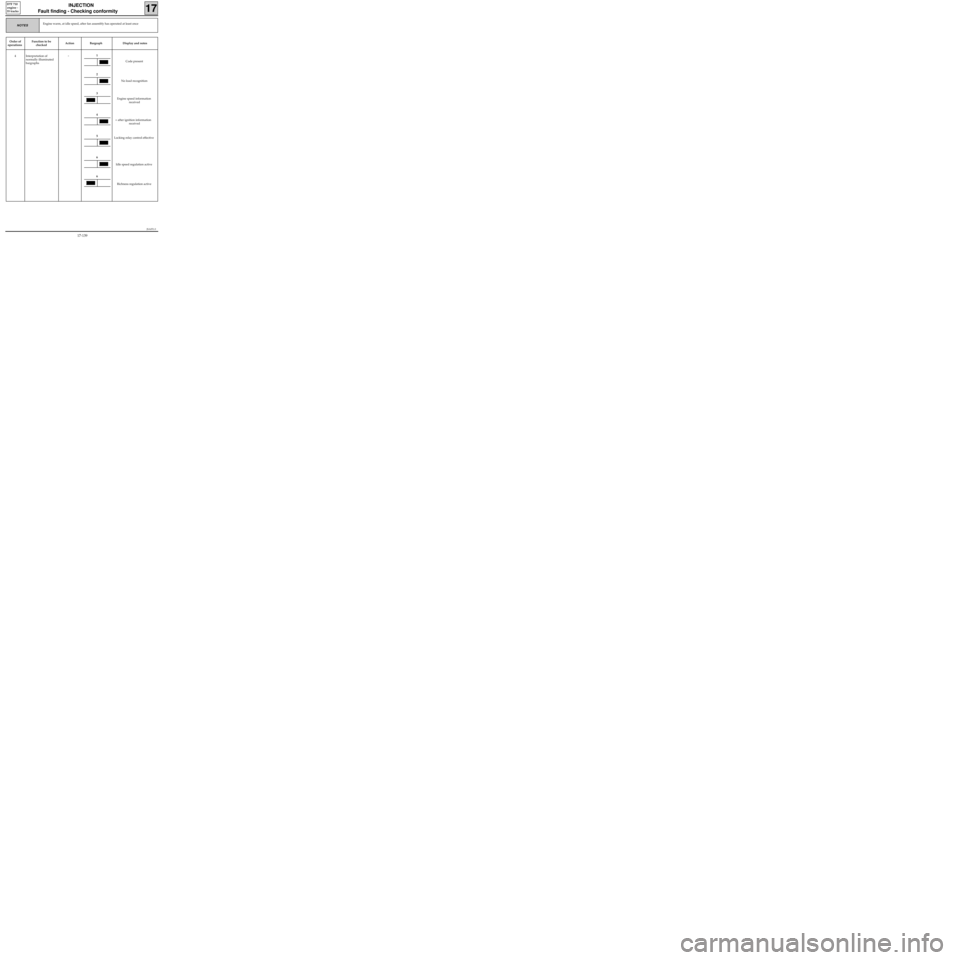
JSA051.0
INJECTION
Fault finding - Checking conformity
17
D7F 710
engine -
35 tracks
Engine warm, at idle speed, after fan assembly has operated at least once NOTES
Order of
operationsFunction to be
checkedAction Bargraph Display and notes
4 Interpretation of
normally illuminated
bargraphs
-
Code present
No load recognition
Engine speed information
received
+ after ignition information
received
Locking relay control effective
Idle speed regulation active
Richness regulation active1
2
5
4
6
6
3
17-139
Page 185 of 363
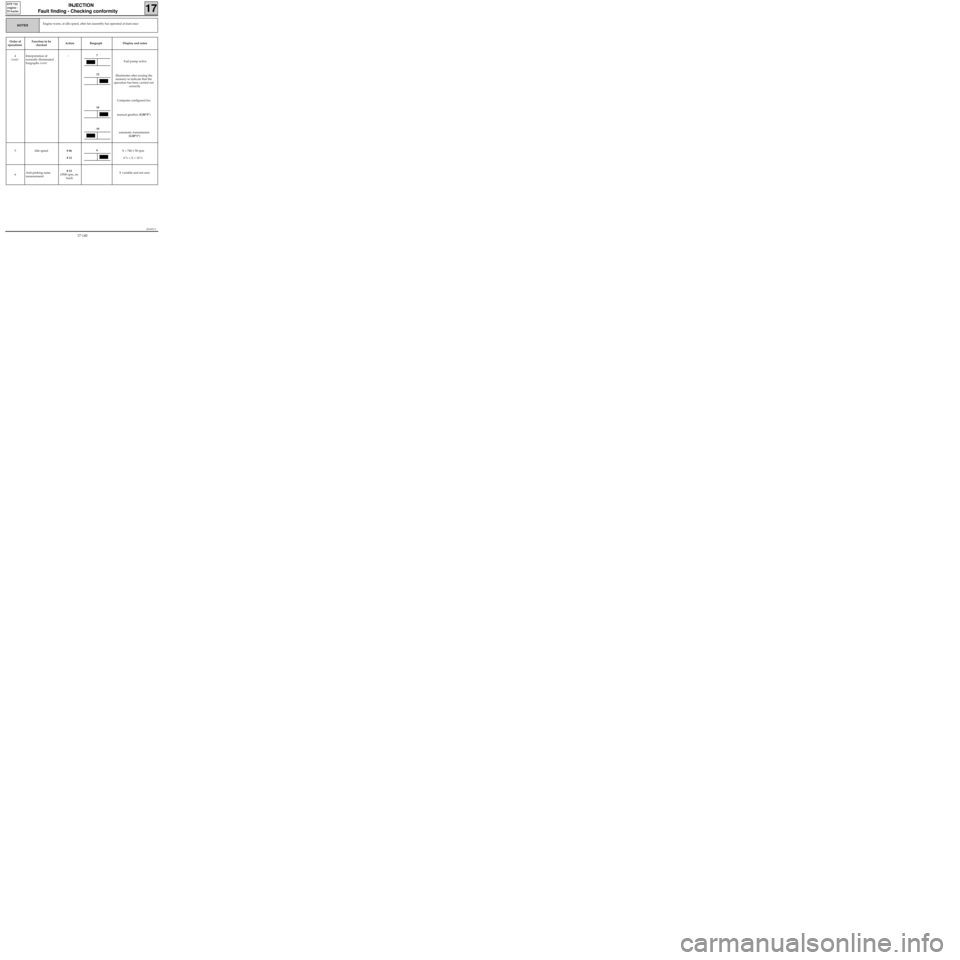
JSA051.0
INJECTION
Fault finding - Checking conformity
17
D7F 710
engine -
35 tracks
Engine warm, at idle speed, after fan assembly has operated at least once NOTES
Order of
operationsFunction to be
checkedAction Bargraph Display and notes
4
(cont)Interpretation of
normally illuminated
bargraphs (cont)
-
Fuel pump active
Illuminates after erasing the
memory to indicate that the
operation has been carried out
correctly
Computer configured for:
manual gearbox (G50*2*)
automatic transmission
(G50*1*)
5 Idle speed# 06
# 12X = 740 ± 50 rpm
4 % < X < 14 %
6Anti-pinking noise
measurement# 13
(3500 rpm, no
load) X variable and not zero
7
19
12
19
6
17-140
Page 186 of 363
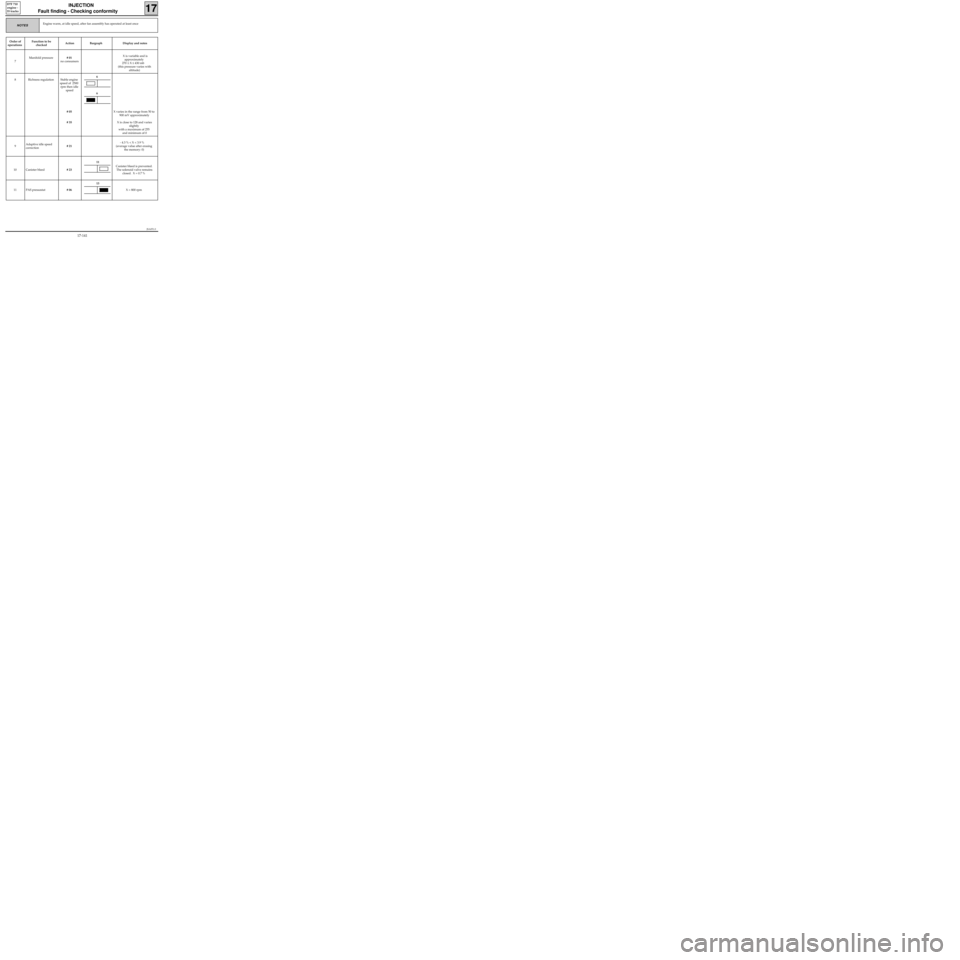
JSA051.0
INJECTION
Fault finding - Checking conformity
17
D7F 710
engine -
35 tracks
NOTES
Order of
operationsFunction to be
checkedAction Bargraph Display and notes
7Manifold pressure# 01
no consumers X is variable and is
approximately
270 ≤ X ≤ 430 mb
(this pressure varies with
altitude)
8 Richness regulation Stable engine
speed of 2500
rpm then idle
speed
# 05
# 35X varies in the range from 50 to
900 mV approximately
X is close to 128 and varies
slightly
with a maximum of 255
and minimum of 0
9Adaptive idle speed
correction# 21- 4.3 % < X < 3.9 %
(average value after erasing
the memory: 0)
10 Canister bleed# 23Canister bleed is prevented.
The solenoid valve remains
closed. X = 0.7 %
11 PAS pressostat# 06X = 800 rpm
Engine warm, at idle speed, after fan assembly has operated at least once
6
6
11
13
17-141
Page 187 of 363
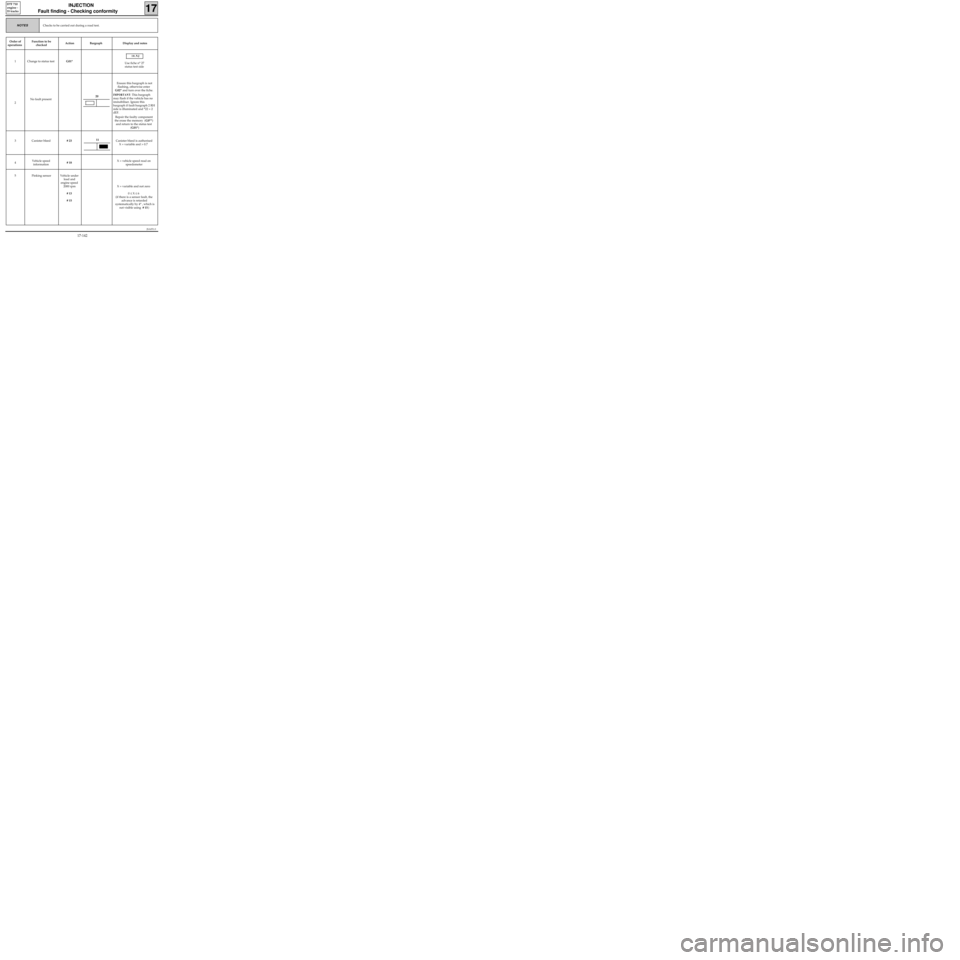
JSA051.0
INJECTION
Fault finding - Checking conformity
17
D7F 710
engine -
35 tracks
Checks to be carried out during a road test.NOTES
Order of
operationsFunction to be
checkedAction Bargraph Display and notes
1 Change to status testG01*
10.NJ
Use fiche n° 27
status test side
2No fault presentEnsure this bargraph is not
flashing, otherwise enter
G02* and turn over the fiche.
IMPORTANT: This bargraph
may flash if the vehicle has no
immobiliser. Ignore this
bargraph if fault bargraph 2 RH
side is illuminated and *22 = 2
dEF.
Repair the faulty component
the erase the memory (G0**)
and return to the status test
(G01*)
3 Canister bleed# 23Canister bleed is authorised
X = variable and > 0.7
4Vehicle speed
information# 18X = vehicle speed read on
speedometer
5 Pinking sensor Vehicle under
load and
engine speed
2000 rpm
# 13
# 15X = variable and not zero
0 ≤ X ≤ 6
(if there is a sensor fault, the
advance is retarded
systematically by 4° , which is
not visible using # 15)
11
20
17-142
Page 188 of 363
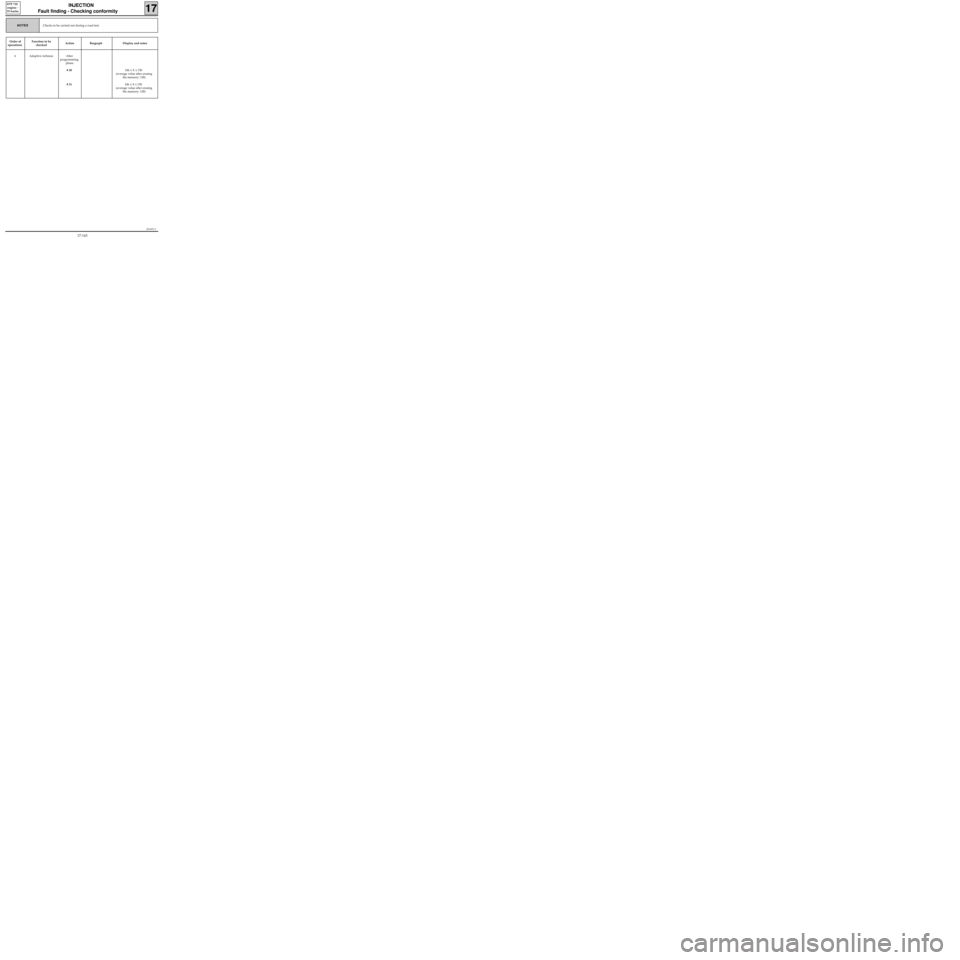
JSA051.0
INJECTION
Fault finding - Checking conformity
17
D7F 710
engine -
35 tracks
Checks to be carried out during a road test.NOTES
Order of
operationsFunction to be
checkedAction Bargraph Display and notes
6 Adaptive richness After
programming
phase
# 30
# 31 106 ≤ X ≤ 150
(average value after erasing
the memory: 128)
106 ≤ X ≤ 150
(average value after erasing
the memory: 128)
17-143
Page 189 of 363
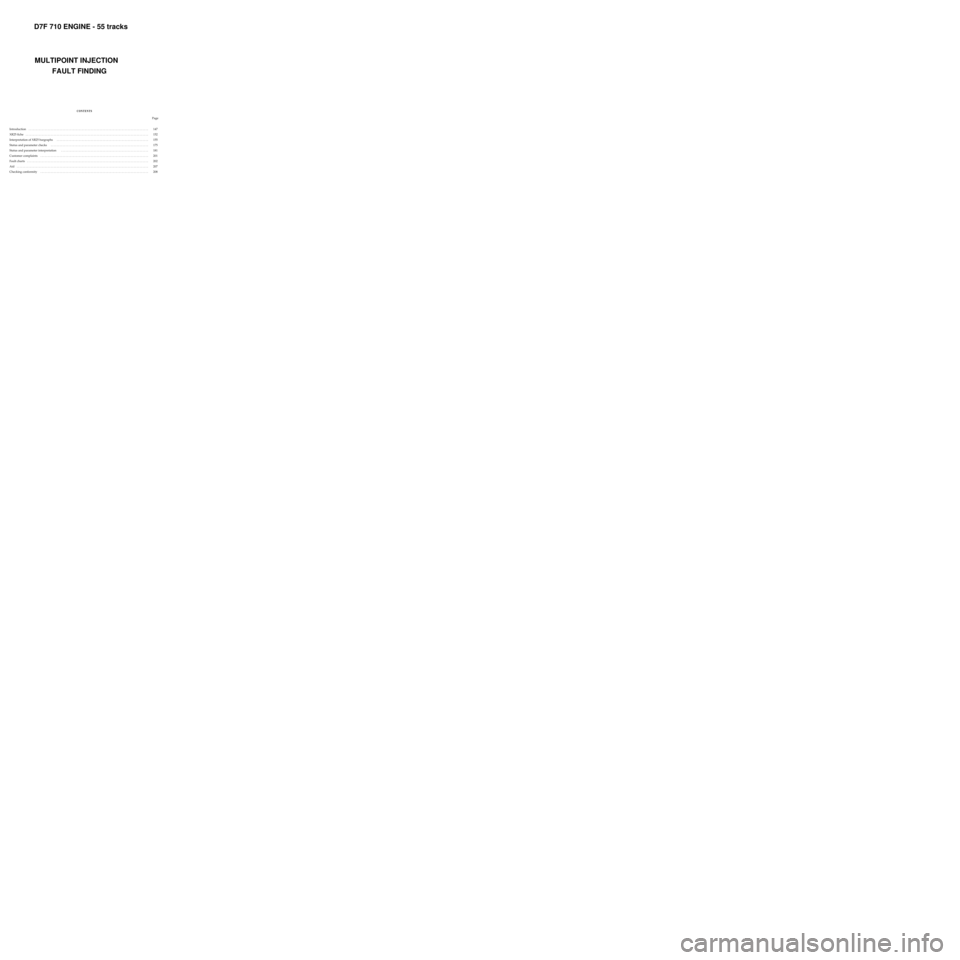
D7F 710 ENGINE - 55 tracks
MULTIPOINT INJECTION
FAULT FINDING
CONTENTS
Introduction . . . . . . . . . . . . . . . . . . . . . . . . . . . . . . . . . . . . . . . . . . . . . . . . . . . . . . . . . . . . . . . . . . . . . . . . . . . . . . . . . 147
XR25 fiche . . . . . . . . . . . . . . . . . . . . . . . . . . . . . . . . . . . . . . . . . . . . . . . . . . . . . . . . . . . . . . . . . . . . . . . . . . . . . . . . . . . 152
Interpretation of XR25 bargraphs . . . . . . . . . . . . . . . . . . . . . . . . . . . . . . . . . . . . . . . . . . . . . . . . . . . . . . . . . . . . . . 155
Status and parameter checks . . . . . . . . . . . . . . . . . . . . . . . . . . . . . . . . . . . . . . . . . . . . . . . . . . . . . . . . . . . . . . . . . . 175
Status and parameter interpretation . . . . . . . . . . . . . . . . . . . . . . . . . . . . . . . . . . . . . . . . . . . . . . . . . . . . . . . . . . . 181
Customer complaints . . . . . . . . . . . . . . . . . . . . . . . . . . . . . . . . . . . . . . . . . . . . . . . . . . . . . . . . . . . . . . . . . . . . . . . . . 201
Fault charts . . . . . . . . . . . . . . . . . . . . . . . . . . . . . . . . . . . . . . . . . . . . . . . . . . . . . . . . . . . . . . . . . . . . . . . . . . . . . . . . . . 202
Aid . . . . . . . . . . . . . . . . . . . . . . . . . . . . . . . . . . . . . . . . . . . . . . . . . . . . . . . . . . . . . . . . . . . . . . . . . . . . . . . . . . . . . . . . . 207
Checking conformity . . . . . . . . . . . . . . . . . . . . . . . . . . . . . . . . . . . . . . . . . . . . . . . . . . . . . . . . . . . . . . . . . . . . . . . . . 208Page
Page 190 of 363
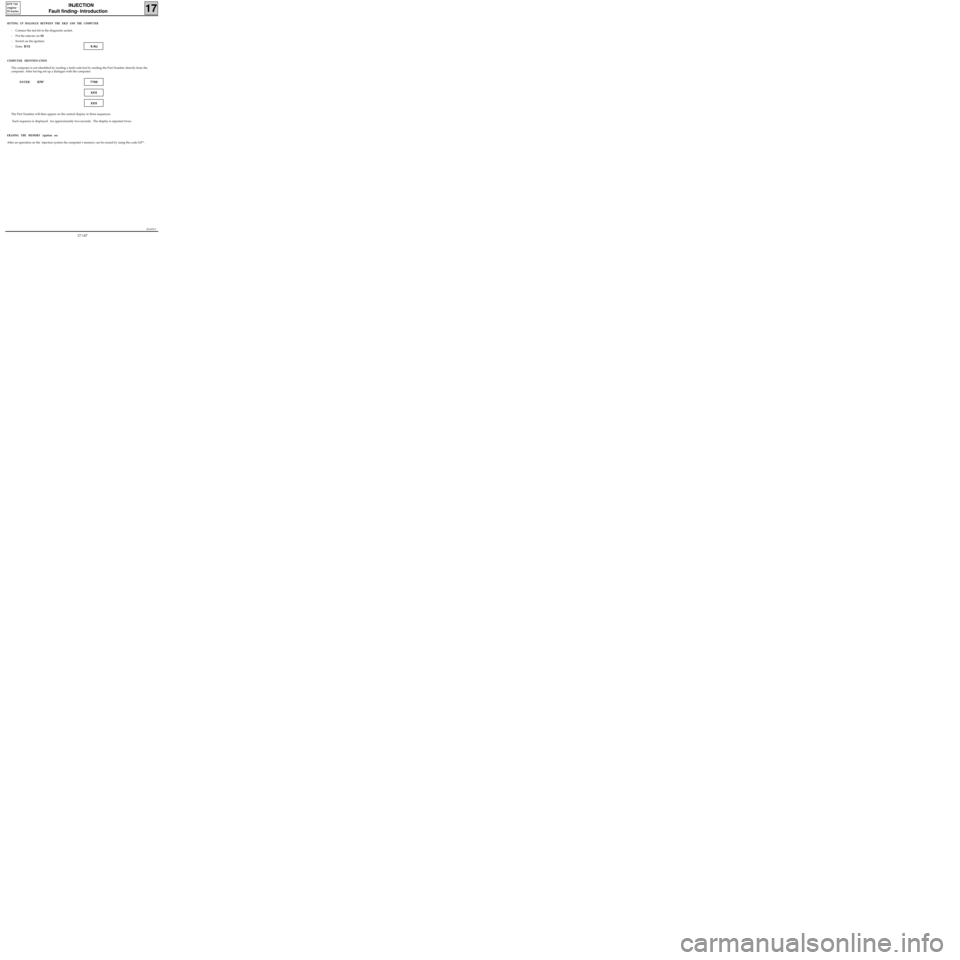
JSA052.0
INJECTION
Fault finding- Introduction
17
D7F 710
engine -
55 tracks
SETTING UP DIALOGUE BETWEEN THE XR25 AND THE COMPUTER
- Connect the test kit to the diagnostic socket.
- Put the selector on S8
- Switch on the ignition.
- Enter D13 9.NJ
COMPUTER IDENTIFICATION
The computer is not identified by reading a fault code but by reading the Part Number directly from the
computer. After having set up a dialogue with the computer:
ENTER G70*7700
XXX
XXX
The Part Number will then appear on the central display in three sequences.
Each sequence is displayed for approximately two seconds. The display is repeated twice .
ERASING THE MEMORY (ignition on)
After an operation on the injection system the computer’s memory can be erased by using the code G0** .
17-147
Page 191 of 363
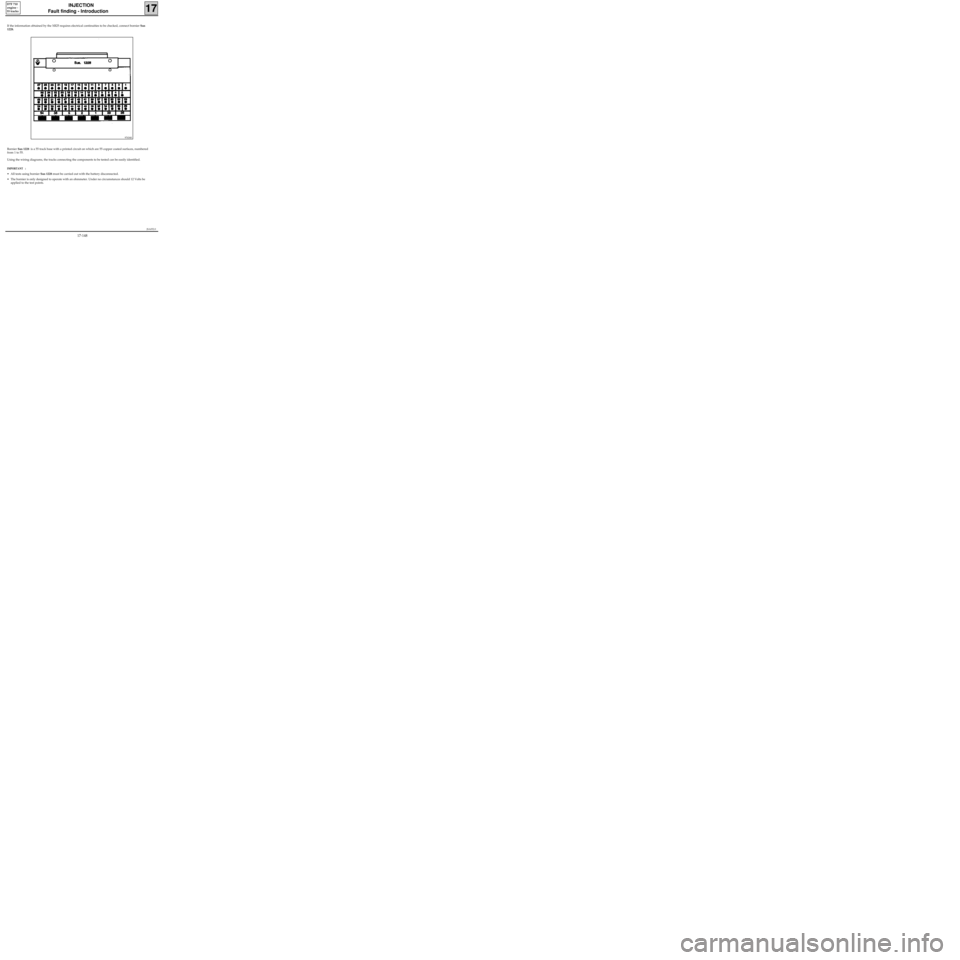
JSA052.0
INJECTION
Fault finding - Introduction
17
D7F 710
engine -
55 tracks
If the information obtained by the XR25 requires electrical continuities to be checked, connect bornier Sus
1228.
Bornier Sus 1228 is a 55 track base with a printed circuit on which are 55 copper coated surfaces, numbered
from 1 to 55.
Using the wiring diagrams, the tracks connecting the components to be tested can be easily identified.
IMPORTANT :
• All tests using bornier Sus 1228 must be carried out with the battery disconnected.
• The bornier is only designed to operate with an ohmmeter. Under no circumstances should 12 Volts be
applied to the test points.
97434S
17-148
Page 192 of 363
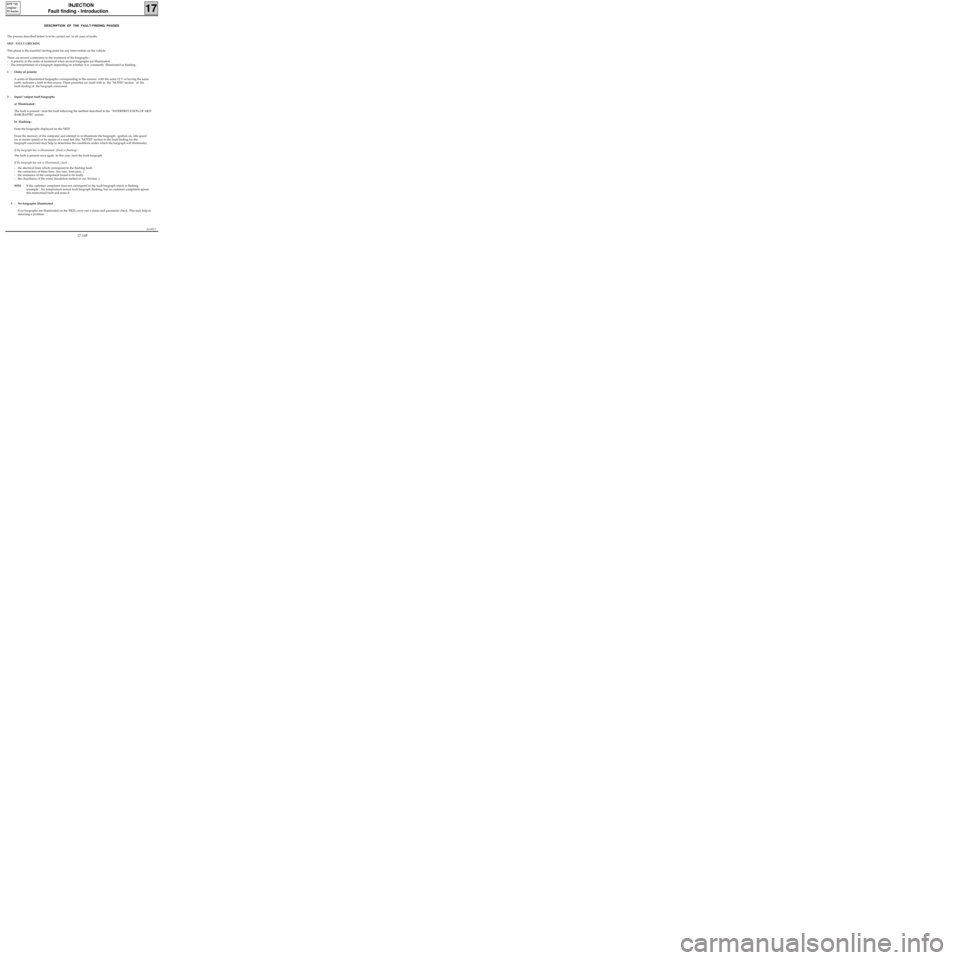
JSA052.0
INJECTION
Fault finding - Introduction
17
D7F 710
engine -
55 tracks
DESCRIPTION OF THE FAULT-FINDING PHASES
The process described below is to be carried out in all cases of faults.
XR25 FAULT-CHECKING
This phase is the essential starting point for any intervention on the vehicle.
There are several constraints to the treatment of the bargraphs :
- A priority in the order of treatment when several bargraphs are illuminated.
- The interpretation of a bargraph depending on whether it is constantly illuminated or flashing .
1 - Order of priority
A series of illuminated bargraphs corresponding to the sensors with the same 12 V or having the same
earth, indicates a fault in this source. These priorities are dealt with in the "NOTES" section of the
fault-finding of the bargraph concerned.
2 - Input / output fault bargraphs
a) Illuminated :
The fault is present : treat the fault following the method described in the "INTERPRETATION OF XR25
BARGRAPHS" section.
b) Flashing :
Note the bargraphs displayed on the XR25.
Erase the memory of the computer and attempt to re-illuminate the bargraph: ignition on, idle speed
(or at starter speed) or by means of a road test (the "NOTES" section in the fault finding for the
bargraph concerned may help to determine the conditions under which the bargraph will illuminate).
If the bargraph has re-illuminated (fixed or flashing) :
The fault is present once again. In this case, treat the fault bargraph.
If the bargraph has not re-illuminated, check :
- the electrical lines which correspond to the flashing fault,
- the connectors of these lines (for rust, bent pins...).
- the resistance of the component found to be faulty.
- the cleanliness of the wires (insulation melted or cut, friction..).
NOTE : If the customer complaint does not correspond to the fault bargraph which is flashing
(example : Air temperature sensor fault bargraph flashing, but no customer complaint) ignore
this memorised fault and erase it.
3 - No bargraphs illuminated
If no bargraphs are illuminated on the XR25, carry out a status and parameter check. This may help in
detecting a problem.
17-149